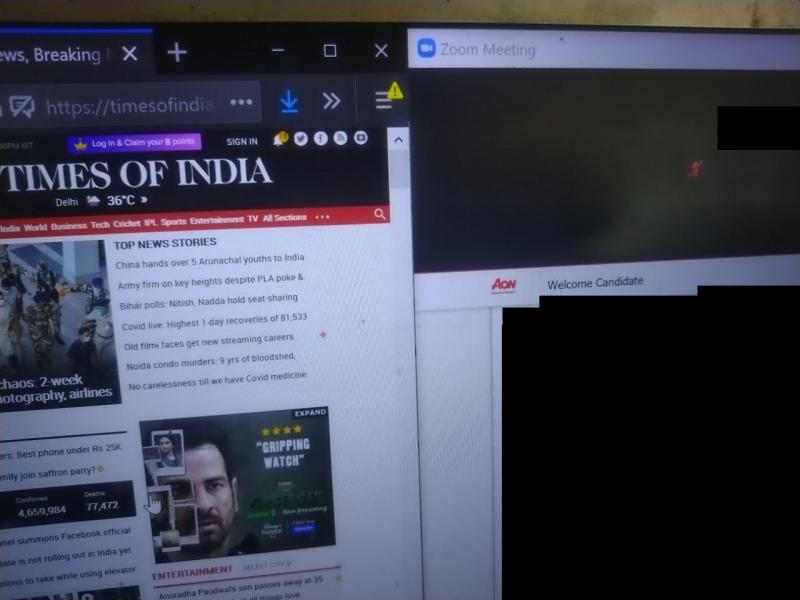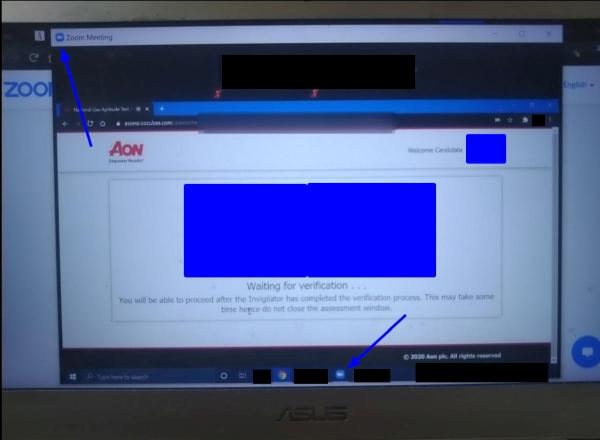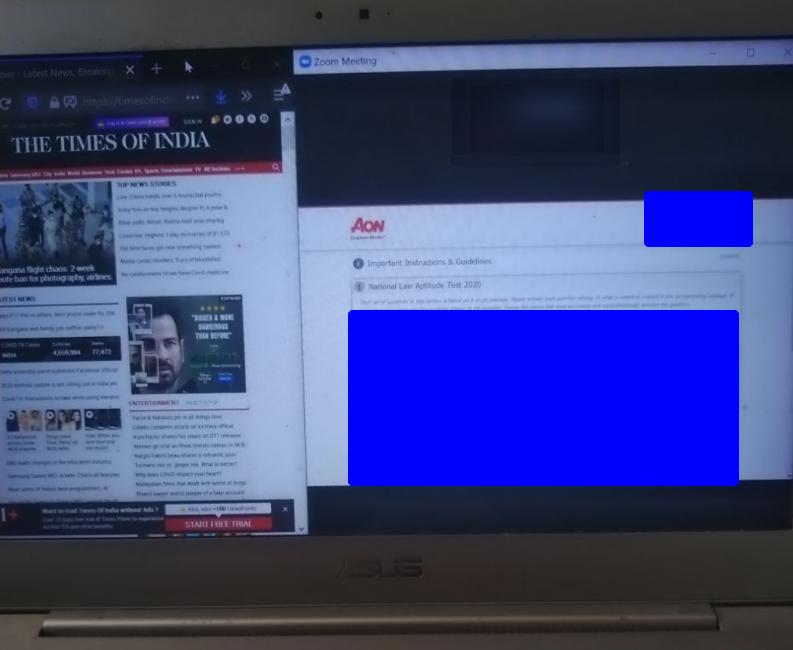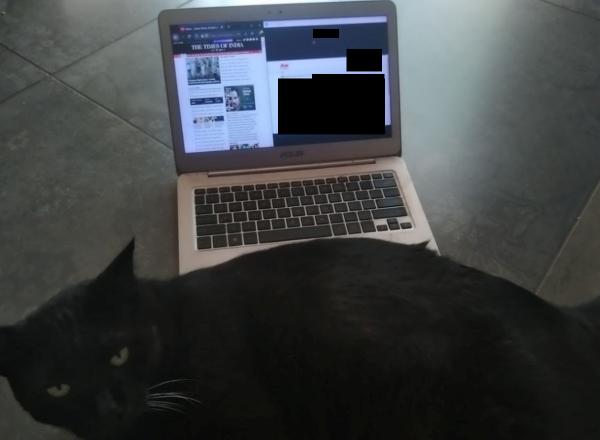
We have just witnessed a live demonstration that the National Law Aptitude Test (NLAT), the online home-proctored admissions test announced eight days ago by NLSIU Bangalore that has taken place today, is impossible to conduct without significant risk of cheating.
We can confirm that it will be all but impossible for NLSIU to eliminate attempts to gain unfair advantages on the exam, even if only needing to weed out the dishonest from the top 80 candidates out of the up to 27,500 candidates (or at least those who managed to log in).
NLSIU, for one, when asked whether it could identify the candidate, has commented that they would be disqualified (see below). However, this seems unlikely based on the technology that was in play today, which did not include the full software suite normally offered by NLS’ vendor.
The final slot of the NLAT that started at 4pm has just concluded, as at the time of publication.
Step 1: How to Zoom conference, NLAT style

Shortly after 2pm, several minutes before the second slot of the NLAT was due to start, we were sent an invite to a Zoom video chat room.
When we followed the link and joined the room, we began witnessing one candidate’s entire 45-minute NLAT exam session live via Zoom’s screen sharing feature, including with repeated attempts at the initial verification of their face and photo ID, and the minutes spent waiting for each verification / rejection to take place.
At no point did the proctoring system flag anything (except for some of the sorts of messages that a lot of candidates received, such as ‘excessive background noise’, please make sure your face is fully visible on screen, etc; it is conceivable the sensitivity of the AI proctoring system was ramped up today, resulting in a lot of false positives).
We watched the entire 45 minute exam, until its submission.
Step 2: ???

Once someone else has access to your screen (and there are many different ways of doing that, besides just Zoom, as outlined in our earlier article), it is pretty much game over, as far as the exam’s sanctity is concerned.
If you are determined enough, you can enlist a committee of friends or even experts, with ready access to Google, calculators and years of experience of cracking entrance tests and reading comprehension questions.
Then, there are thousands of different and obvious ways of communicating the correct answers to whatever question is currently on screen. These include the very easy (but a tiny bit risky) method (which has been demonstrated on Twitter with chopsticks) of just sticking a mobile phone in front of or behind your laptop screen, and then receiving (silent) text chat message updates with the correct answers from your expert counterparties. Conceivably, the NLAT can try to argue that it might be possible to detect hints of this happening with perfect eye-tracking technology from low-resolution webcam footage, unlikely as that seems.
Even safer (but slightly more complicated) would be electronic buzzers or mobile phones in your pocket that can signal you via vibrations, morse code or other agreed-upon signals, which one is the right answer. Even a human super proctor physically standing in your room might not necessarily be able to detect something like that.
Alternatively, in perhaps the most low-tech approach of all for this kind of online exam: a very smart person with a laptop watching your livestream sits under your desk and taps you on the leg in code to indicate the right answers.
Step 3: Profit / loss
While we only saw the first step demonstrated, the second step is trivial to implement for any candidate seriously looking to extract a massive advantage over other candidates.
This creates a huge problem for the sanctity of the NLAT and it does not appear there are any realistic solutions to stop this.
An issue of software
We asked NLS official for comment and to identify the candidate who had shared their screen with us via Zoom.
A member of NLS’ administration commented: “All candidates actions are logged. This candidate will be disqualified.”
The problem is, it may literally be impossible for the NLAT to do so with the technology it employed.
According to IT experts, we understand that modern web browsers intend to make it impossible for software or web pages running in a tab (such as the NLAT online exam), to get information about any other software or processes that are running on a computer, including Zoom or Skype or any other of myriad other screen sharing apps.
The only way for a website to find out which software you are running on your computer would be if it exploited a so-called zero-day security bug in the browser.
Modern browsers, such as Google Chrome or Mozilla Firefox or Apple’s Safari, use sophisticated and advanced techniques known by terms such as sandboxing, to ensure no nefarious website can find out what websites are open in another tab on your browser, let alone what else is running on your computer right now. or which documents you are editing in your Word Processor or what emails you are reading.
If it was possible for the NLAT to find out that Zoom was running, the vendors would be sitting on a bug that, if disclosed to browser vendors, could net you lakhs to potentially millions of dollars, or even more on cybercrime black markets.
It therefore seems highly likely that the audit logs will be limited in usefulness at present.
We have also reached out to Aon Cocubes for comment on the above.
Why is Zoom even possible?

However, most proctored exams would not have allowed you to run software such as Zoom in the background.
As we had already reported in our post-mock exam analysis of the risk of cheating, the NLAT problem boils down to software.
From our LSAT-India interview from July, about its home-proctored test, we asked about the need to download a separate piece of software on candidates’ computers, other than just a web browser window:
the software developed by LSAC partner and international testing multinational Pearson Vue, has a few tricks up its sleeve.
First of all, it was properly compatible only with Windows operating systems (OS), which means no dice for those on Macs (and probably none for Linux or other niche OS users either, though Abdul-Kareem was not able to confirm that for sure).
The programme running on candidates computers, will then take complete control of the system, much like an anti-virus programme (or indeed, a virus) might, and shut down everything else running on the computer, so you are left with only the test window.
Initially, the NLAT too had required candidates to download a separate Google Chrome browser extension, called Safe Assessment Browser (SAB) Tool.
This SAB tool would probably have given the NLAT much wider access to what’s going on in your computer, including presumably detecting that Zoom is running in the background and streaming your entire session.
However, as suspected, yesterday’s FAQ update confirmed that the SAB tool, which some candidates were looking for in vain, was “no longer required for the exam”.
This was most likely a consequence to NLS’ admirable aim of making the NLAT accessible to a wider variety of operating systems (OS) than just Windows, which happened only four days before the exam when the exam was ported to Android, MacOS and Linux, which appears to have been done by simply running the exam in the web-browser, without the SAB tool software.
But compared to other admissions tests such as the LSAT-India or the SLAT (which also forced you to install a software tool on your computer), the lack of such a software will give NLS and its tech vendor, Aon-owned company Cocubes, a very limited data trail to do a forensic analysis on about what was happening on a candidate’s laptop, whether using machine learning or not.
Is there any way NLAT could still catch a 'good' cheater?
As far as we can see, the only possible way that remains of identifying candidates who managed to cheat successfully, would be to disqualify candidates who performed too well.
If someone gets 100% on the NLAT, it’s a good sign that they cheated, particularly if they get 100% in sections such as general knowledge or maths.
On the other hand, seeing as the exam is only 40 questions over 45 minutes, how can you say for sure, on the basis of the scores alone, that you are not dealing with a genius who got lucky?
If the NLAT will have to begin taking calls on a case-by-case basis on whether the 2020 batch of NLSIU will consist of cheaters or geniuses, the entire exercise will be in trouble.
threads most popular
thread most upvoted
comment newest
first oldest
first
1) Students or LI, CLAT, whoever - reach out with details and individual accounts of test-takers to news channels. Run up the rhetoric on glitches in conduct of exam, pair it with future of aspirants, and importance that justice is 'seen to be done.'
2.a) Stick to argument on by-laws in the SCI; 2.b) while noting the 'media reporting' for the bench. Obviously, (2.b) can only happen if (1) is successfully done.
Thanks Kian.
It's really funny how they blamed Venkata Rao for supposedly lowering standards for 10 years only to turn themselves into a national joke once he was gone. And now he is the only thing standing in the way of their total implosion - wishing him and the CLAT consortium all the best in court next week. They may yet manage to protect NLSIU from the devastation being caused by this new administration of the alumni elite.
The vast majority of Law School alumni are also laughing (sadly) at this circus that Sudhir and his cronies have brought about.
Their argument in the KA HC for the domicile reservation issue was that NLS is some kind of IISc-like autonomous institution which cannot be subject to any legal state reservation even though it is clearly only a state university. They don't provide the constitutionally-mandated OBC or EWS quotas for Central institutes because the KA govt. doesn't impose them on its state universities and while taking advantage of this, they had the gall to argue against the KA domicile quota saying they don't come under the KA government. If such nonsense is allowed, why don't they stop having SC/ST reservation as well and make themselves truly "elite"?
Simultaneously, they made a slimy self-serving argument to throw all other NLUs under the bus by saying that they should all have state quota reservation because they're like KSLU, which is purely misleading the Court on facts and the intent behind the NLU nomenclature.
For the record, I am against domicile quotas since they are used mainly for political purposes, but the arguments by their "star alumnus" Mr. Banerjee, based on his power of attorney from the incompetent Bar Council, left me quite infuriated. I do hope the High Court seriously deliberates on this issue in its final order rather than relying on such legally untenable arguments. This is very similar to how they've been going to the SC and saying that they are the only law school with the trimester system even though NLIU still has it. The Court must take note of this BS.
I, for one, truly hope that Srividya (or any other NLS alum) doesn't take over at NLUD (or any other top-tier NLU). There's a better chance, at this point, that most of them are in some active collusion to bring down other competing law schools rather than to use their first-mover advantage to actually bring some positive change to legal education in the country. Their insecurity about competition and the desperation to prove their "superiority" on an unequal playing field is downright disgusting.
Funnily enough, the letterhead on the Reg's letter now states that NLS is "sponsored by the Bar Council of India" - whatever the hell that's supposed to mean. The BCI barely has any money to run its own business in Delhi, forget "sponsoring" a full-fledged university. It's obvious that the NLS Admin is slowly attempting to change the communication narrative about NLS from being a State University to one that is some specialised body like the CSIR or something. This BS has to be put to an end.
Since the Registrar is the custodian of all records, I think she should be directed to reveal who were the EC members present and voting between Aug 6 -18 when the carte blanche was unanimously given to Messiah to CLAxit should Sep 7 test date get rescheduled.
Did Messiah and his Hand honestly explain and disclose things to the EC members, especially the SC and BCI representatives?
After this debacle, Messiah and his Hand should be sent on leave and an inquiry initiated. There is more to this than someone's inflated ego; desire to underline the so-called superior status of NLS; humiliate so-called TLC lobby etc
Messiah has always been inflated ego personified. But he is no fool. This was high stakes. To me it looks that CLAxit was supposed to happen much earlier. However, Messiah wasn't getting an opening. Time was running out. Hence it became a make-or-break situation. The Hand always knew. Following orders isn't good enough.
And let's not say alumni aren't able to do anything about it: they were out and about in big numbers trying to make sure Sudhir got the job and they succeeded. They have just conveniently retreated to the shadows and hidden from the bitter truths about this new administration because actually they don't care. Sorry to paint all NLS alumni by the same brush but if you don't want to be judged then speak up like some of the younger exceptions.
@Kian - Now I am intrigued!! Is it your cat or your girlfriend's or colleague's?
What will happen if they cancel the exam?
Will they refund the fees?
Will NLSIU become a member of the consortium
WE want the answers for these questions!
Maybe now, some of these prominent haters will have some shame finally and admit their narrow mindedness.
I really hope that the Supreme Court scraps this ridiculous examination.
I feel NLUs have been deteriorated beyond repair in last 10 years and some of them are not better than second rate degree colleges.
Out of 24-25 NLU, half of them don't have full-time VC or Registrar. Half of them don't have even 5 Full professors. Faculty situation is absolutely pathetic in majority of places.
Some of the NLUs deserve to be closed. High courts have said so.
NLAT and CLAT are classic examples, these guys can't conduct a proper Admission process. Leave Jindal. Symbiosis, Christ, KIIT and Amity have done better.
Islands of excellence must not become fool's paradise.
In case you really want to talk about NLUs, they are still making legal education available to the people of this country at a much more affordable rate than JGLS ever would. Not that it means NLUs are paragons of accessibility themselves.
My chambers will personally be accessing and collating this.
Gopal Sankaranarayanan
P.S. I am calling Kian to confirm that this is my comment
twitter.com/sharvvii/status/1304753115611066370
twitter.com/neelesh_purohit/status/1304740772655235074
twitter.com/Abhijeet9661/status/1304729694743400448
twitter.com/Shivang83239043/status/1304770103653748736
twitter.com/Shivam83295479/status/1304769038581604352
twitter.com/Ranjitksrivast1/status/1304768321825337345
twitter.com/dalaalium/status/1304767693963231234
twitter.com/RamblerLama/status/1304764062614478848
twitter.com/Meenakshi_2002/status/1304765882657206284
twitter.com/Hemang67742372/status/1304763758313533440
twitter.com/surendr10792201/status/1304760893947826176
twitter.com/SwatiPr54910877/status/1304758277905903619
twitter.com/bhawini07/status/1304757638169849857
twitter.com/Areebuddin14/status/1304755865065455616
twitter.com/PratishthaDiwa1/status/1304722931268820992
twitter.com/moonmermaid_/status/1304752193791078401
twitter.com/Vanshik73137277/status/1304748602426757128
twitter.com/Ayaan09695269/status/1304747262648623104
twitter.com/StartleManas/status/1304738966386610177
twitter.com/nitinraj081311/status/1304737269547319297
twitter.com/reverse_urban/status/1304735708737753090
twitter.com/holier_than_tau/status/1304728597236576256
twitter.com/PoonamS54271186/status/1304719977530847234
twitter.com/PratishthaDiwa1/status/1304722931268820992
twitter.com/HariniMehrotra/status/1304722268510019584
twitter.com/RohitKu20028022/status/1304683641516113920
twitter.com/DrUdayveerSing4/status/1304692561836081158
twitter.com/BhatiAnurima/status/1304699886772916224
twitter.com/kks150267/status/1304705148145467392
twitter.com/FaizanM72133181/status/1304705237383430144
twitter.com/Rumkimukherjee9/status/1304708447812767745
twitter.com/DrUdayveerSing4/status/1304709388297334784
twitter.com/ShawWantsChange/status/1304714139365830656
twitter.com/Pratimesh10/status/1304715046220476417
twitter.com/PRADHAN_Ji__/status/1304718485931487233
twitter.com/FaizanM72133181/status/1304719244756623365
twitter.com/sabapagarkarsa1/status/1304719776955035648
1. Sudhir has been so uncooperative, that they have been frightened into keeping a low profile so that he won't target his ire at the student body (the recent controversy with the leaking of minutes of meetings and Sudhir's hissy fit subsequently, being case in point)
2. SBA also took a lot of advice during Sudhir's appointment drama from 2 alumni who are clear Sudhir-plants (one of whom is tenured at another NLU). In fact, the new SBA continues to take instructions from the other alumnus. Perhaps the SBA's logic is that these alumni can act as a bridge to Sudhir's decision-making, mediate, help them understand and so on.
Whatever be the case, the SBA is in a very hard place with all this. Wish they were being better advised :(
At the same time, I don't think that the 'Shameerpet Refugee' should be described as a Sudhir-plant. He was probably supporting Sudhir's appointment as VC last year to plan his own return to NLSIU. In the longer-run, that might actually be a good thing for the institution, since he is one of the few people who can actually act as a check on Sudhir for the rest of his term. Even if the Supreme Court cancels the NLAT next week, I don't think that the NLSIU Executive Council will ask him to step down from office.
Messiah games everything in advance. Hence he is Messiah Tywin Lannister who never got shot while taking a dump but dumped CLAT while doing....
Less than 40 odd tweets listed above. Bhai thats what % of the total candidates who appeared.
NLSIU, Bengaluru has not left CLAT Consortium. Nor CLAT Consortium has expelled NLSIU, Bangalore.
There would be no issue at all.
Contrary to what you're saying, no one actually gives a that much of a damn about the "rise of NLS". In fact, it's the other way around where the NLS Alums seem very insecure about the rising level of competition from other law schools and are doing everything in their power to bring others down. Don't think for a second that anyone in their right mind (sadly, most aren't) will hold this 2020 batch (or any future one) in any high regard even if the SC allows the NLAT to stand.
Most of the early batches of NLS were largely mediocre students who couldn't hack it into any other stream in India and competed with some 500 kids for a seat. They eventually got ahead simply because they learnt to speak better English while at law school. Ask your parents if their generation or the one after them ever had ambitions of studying at NLS. They probably won't even know what you're talking about. The entire thing became somewhat attractive only after CLAT and that too because of the salary packages and not the "law school" aspect.
I challenge you to justify the shabby manner of conducting the NLAT while screwing over thousands of aspirants. It's obvious that you can't because you're just a shameless troll who has a weekend to spare while hiding behind the veil of Internet anonymity. Btw, only 25K kids (compared to the 70K who applied for CLAT UG) even appeared for the exam which goes to show that getting through into NLS isn't as life and death as you're making it out to be.
Sorry to burst your bubble, but arguing that you don't care about the minority who suffered due to a faulty scam of an online exam isn't an argument that'll cut its case in any legal arena, especially in our country. You're full of cr*p as I already pointed out. If you truly are a student there, then you're obviously someone at the bottom percentile of your batch who ride on the shoulders of the smarter folks at the place without contributing anything to the Uni.
Coming on here to this site and shouting "we in NLS are better" doesn't make you so when the circumstances clearly show that all your social justice interventions are pretty much just hot-air.
As for me commenting on NLS, I do it with the sole objective of putting the individuals like you in their place and not due to some obsession with the law school. Also, no, I am not as immature as you to get into a d*ck-measuring contest on alumni achievements but your early batches were as incompetent and as lucky as you might have been to make it in there. Except, unlike you, most of them speak/write better in English and have learnt to put forward more logical arguments.
More importantly, "you" didn't "win" in Court. Read the SC Order properly again ([...]). The precise reason for the late NLAT announcement was to avoid any serious judicial scrutiny. Hopefully, the Court sees through this facade. And who else has supported you exactly? Some of your [...] alumni who sway where the wind blows and seem to have zero ethical and moral integrity or character to stand up for people who are lesser privileged? [...]
Helpless? I do care for the aspiring youth of this country but I've finished my law degree years ago and my only interest in this matter is to show you and your dear NLS for the hot-air you really are. And so far, I've kicked your "collective asses" all the way to the back-end of true and factual argumentative engagement.
By the way, genius, even your basic legal knowledge is pretty appalling. The University is a "Public Authority" which is accountable to the citizens in a democracy. It's not accountable to other public authorities. I don't have to be a "public authority" to demand transparency and accountability in the admission process to a "public" university. You can't seriously convince anyone that you're a law student from NLS. Even a law aspirant has more sense than you.
This guy accessed all questions in advance by altering Source Code of test page. Kindly add this to your article.
For those of you who are interested neither did Arun Thiruvengadam have a choice. He failed to get tenure in Singapore twice and had to return to India. No one returned to serve their motherland. They returned to feed their families. Hardly anyone who has earned tenure or professorship abroad has ever returned to India.
Reading your arrogant posts jarred me out of my Sunday evening indolence and forced me to respond, something I'd never do ordinarily.
If you're a law schoolite, I sincerely suggest you step out of your arrogant bubble in assuming you represent the collective will of the 28 batches of alumni and 4 batches of students.
The "office mei tera Baap kaun" rhetoric might work at Spiritus, but that shit most certainly doesn't fly in the real world. You'll be surprised to learn that you'll soon be bending over backwards to accommodate these same "lesser mortals" from other law schools that you're disparaging now, once you start working. Grow up, stop slandering the collective name of the institution with your misplaced arrogance.
Just to add my two cents- there's much concern about how this episode has panned out, at least on the various alumni network groups I'm on. I contribute to the NLSIU scholarship fund every year to help out some of the underprivileged kids who make it to law school, and I have very serious reservations about how my money will be utilised this year, given the integrity issues with this exam.
www.republicworld.com/india-news/education/nlat-2020-students-report-technical-glitches-verification-failures.html
threads most popular
thread most upvoted
comment newest
first oldest
first